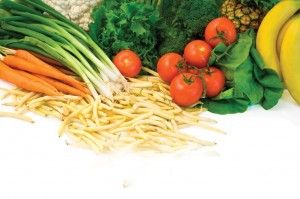

What exactly is dietary fiber?
Dietary fiber, also known as roughage or bulk, includes all parts of plant foods that your body can’t digest or absorb. Unlike other food components such as fats, proteins or carbohydrates — which your body breaks down and absorbs — fiber isn’t digested by your body. In fact, the bonds in grasses and grains are so tough, grazing animals that do eat these exclusively, have stomachs with four chambers, just to break them down. Since humans only have a single chambered stomach, fiber passes relatively intact through your stomach, small intestine, colon and out of the body. It might seem like fiber doesn’t do much, but it has several important roles in maintaining health.
First, here are some basics. Fiber is commonly classified into two categories: those that don’t dissolve in water (insoluble fiber) and those that do (soluble fiber).
- Insoluble fiber. This type of fiber promotes the movement of material through your digestive system and increases stool bulk, so it can be of benefit to those who struggle with constipation or irregular stools. Whole-wheat flour, wheat bran, nuts and many vegetables are good sources of insoluble fiber.
- Soluble fiber. This type of fiber dissolves in water to form a gel-like material. It can help lower blood cholesterol and glucose levels. Soluble fiber is found in oats, peas, beans, apples, citrus fruits, carrots, barley and psyllium.
The amount of each type of fiber varies in different plant foods. To receive the greatest health benefit, eat a wide variety of high-fiber foods.
Benefits of a high-fiber diet
I know you’ve heard this many times, “Eat a well-balanced, high fiber diet,” but do you know why? The well balanced part is simple, variety is the spice of life and it provides you with most of the vitamins and minerals you need for good health. Instead of spending money on supplements, spend it on good food – it tastes better too. The inclusion of a high-fiber diet has many benefits as well, which include:
- Normalizes bowel movements. Dietary fiber increases the weight and size of your stool and softens it. A bulky stool is easier to pass, decreasing your chance of constipation. If you have loose, watery stools, fiber may also help to solidify the stool because it absorbs water and adds bulk to stool. For most, fiber can help minimize the occasional diarrhea and/or constipation. For some, fiber may provide relief from irritable bowel syndrome.
- Helps maintain bowel integrity and health. A high-fiber diet may lower your risk of developing hemorrhoids, and small pouches in your colon (diverticular disease). Think of fiber scrubbing your bowels clean and preventing a back-up. Also, some fiber is fermented in the colon. Researchers are looking at how this may play a role in preventing diseases of the colon.
- Lowers blood cholesterol levels. Soluble fiber found in beans, oats, flaxseed and oat bran may help lower total blood cholesterol levels by lowering low-density lipoprotein, or “bad,” cholesterol levels. Officially, they act as a bile-acid sequesterant. Epidemiologic studies have shown that increased fiber in the diet can reduce blood pressure and inflammation, which is also protective to heart health.
- Helps control blood sugar levels. Fiber, particularly soluble fiber, can slow the absorption of sugar, which for people with diabetes can help improve blood sugar levels. If you’ve ever seen kids at a birthday party and witnessed the spike and crash of blood sugars after the birthday cake extravaganza, you know how detrimental this can be. A high-fiber diet that includes insoluble fiber has been associated with a reduced risk of developing type 2 diabetes.
- Aids in weight loss. Although, there’s no significant calorie “burn” with increased chewing, high-fiber foods generally require more chewing time, which gives your body time to register when you’re no longer hungry, so you’re less likely to overeat. Also, a high-fiber diet tends to make a meal feel larger and linger longer, so you stay full for a greater amount of time. And high-fiber diets also tend to be less “energy dense,” which means they have fewer calories for the same volume of food. The “burn” usually comes from jalapenos added for flavor. Interestingly, if you’re brave enough, there are 3 grams of fiber in a cup of raw jalapenos.
How much fiber do you need?
Speaking of grams of fiber, how much do you need each day? The National Academy of Sciences’ Institute of Medicine, which provides science-based advice on matters of medicine and health, gives the following daily recommendations for adults:
Age 50 and younger Age 51 and older
Men 38 grams 30 grams
Women 25 grams 21 grams
Your best fiber choices
If you aren’t getting enough fiber each day, you may need to boost your intake. Good choices include:
- Grains and whole-grain products
- Beans, peas and other legumes
- Fruits
- Vegetables
- Nuts and seeds
This list is referring to high-fiber foods as we find them on the farm. Refined or processed foods — such as canned fruits and vegetables and pulp-free juice, white bread and pasta, non-whole-grain cereals and Twinkies® — are much lower in fiber content. The grain-refining process removes the outer coat (bran) from the grain, which lowers its fiber content. Similarly, removing the skin from fruits and vegetables decreases their fiber content.
Fiber supplements are helpful, but whole foods are generally more effective and better for you. Fiber supplements — such as Metamucil®, Citrucel® and FiberCon® — don’t provide the vitamins, minerals and other beneficial nutrients
 Southwest Florida's Health and Wellness Magazine Health and Wellness Articles
Southwest Florida's Health and Wellness Magazine Health and Wellness Articles

